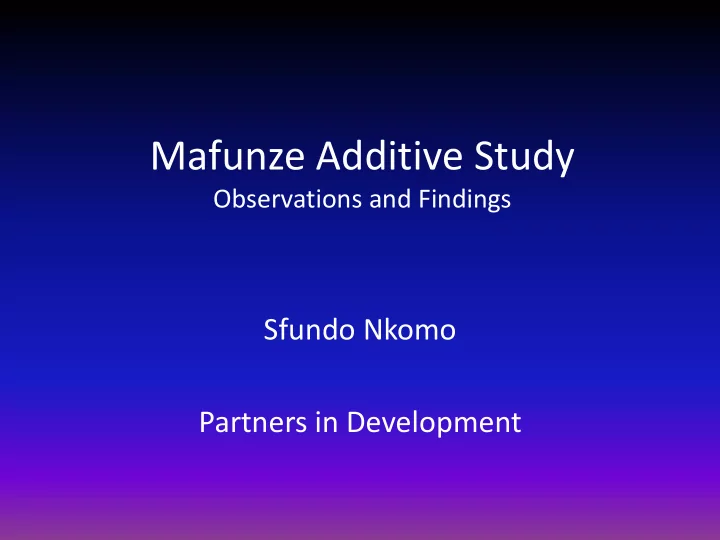

Mafunze Additive Study Observations and Findings Sfundo Nkomo Partners in Development
Why Mafunze? • Latrines of known design • Latrines of known age • PID working in community already so no problem with access, councillors etc
Preliminary Measurements • 50 households with VIPs were visited • Pit management practices were assessed • Photograph of each pit taken and odour level assessed subjectively • Pit contents measured using a laser tape • The 40 pits required for the trial were selected • Grouped into 2 blocks: medium or low rubbish and a high rubbish block
Typical Mafunze Latrine One of the worst latrines in terms of rubbish content
Trial Design • 5 pits from each block were allocated to each of four treatments: • Treatment 1 Micromune proprietary pit additive • Treatment 2 Molasses and water (mixed to 1:5) • Treatment 3 Coloured water (standard food colour ant 1ml/litre) • Treatment 4 Nothing added • Trial run over 16 weeks period
Field work • 3 litres dosed initially followed by 1 litre • 5 heights measurements taken before dosing • 4 readings taken at 0.5 m offset from centre plus centre reading • Dosage increased to 2 litres after 8 weeks • Photograph of each pit taken at end of study
Results • Changes in sludge height calculated every 2 weeks • Means and medians compared for each treatment • Total change in height determined from beginning to end • Average and median change for each treatment calculated • Table 1 shows the increase in sludge height for 4 treatments for the entire study period • Figure 1 shows the fortnightly cumulative changes in sludge height • Figure 2 shows median changes in sludge height for offset measurements
Median Change in sludge height at Treatment centre (mm) 1: Micromune 78 2: Molasses 55 3: Coloured water 38 4: Control 39 Table 1: Sludge Accumulation for entire trial period
100 Change in sludge height 80 60 (mm) 40 20 0 -20 -40 0 2 4 6 8 10 12 14 16 Time (Weeks) Micromune Molasses plus Water Coloured Water Control - nothing added Figure 1: Median cumulative increase in sludge level
40 Change in sludge height (mm) 30 20 10 0 -10 -20 4 6 8 10 12 14 16 Time (weeks) Micromune Molasses plus water Coloured water Control - nothing added Figure 2: Median changes in sludge height from four offset measurements (0.5 metre offset)
Observations • Increases equate to filling rates of between 300 and 600 litres in 1 year, but only if height increase was uniform across pit • Sludge height increase for offset measurements for all cases was negligible • Median increase for first 3 years was 307 litres per year • The additive group had the highest increase
Observations • After 6 weeks all users in first 3 treatment groups reported a reduction in odour • At least two latrines were found with bad odours from each treatment group • Results show odour reduction is somewhat subjective and hard to evaluate • Participants prone to see results that they think perhaps will please researcher • Table 2 shows results of user perceptions of odour reduction
Table 1:User perceptions of odour reduction in VIPs and independent assessment Week 10 Week 16 Bad odour Bad odour Perceived Perceived (assessment (assessment reduction reduction by by Treatment in odour in odour researcher) researcher) (users) (users ) 1: 2/10 3/10 9/10 6/10 Micromune 4/10 3/10 2: Molasses 10/10 10/10 3/10 4/10 3: Coloured 10/10 6/10 water 0/10 2/10 4: Control 5/10 9/10 Table 1:User perceptions of odour reduction in VIPs and independent assessment
Recommend
More recommend